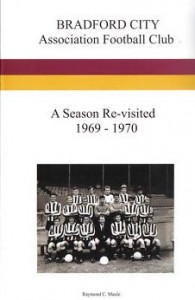Coral Windows Stadium, Valley Parade: Bradford City AFC
Tuesday 14 May 2013
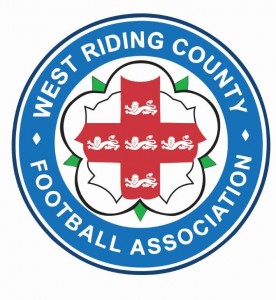 The first winners of the County Cup were Leeds United Reserves in 1927 and apart from 1932 and the period from 1934 to 1949, it has been played for every season since. Goole AFC have won the trophy on most occasions with 13 wins, the first of which came in 1951 when they were known as Goole Town. Their last Cup win was in 2007 at Woodlesford (West Riding County FA Headquarters), when they beat Guiseley 3-1 with goals from Andy Parton and a brace from Duncan Bray.
The first winners of the County Cup were Leeds United Reserves in 1927 and apart from 1932 and the period from 1934 to 1949, it has been played for every season since. Goole AFC have won the trophy on most occasions with 13 wins, the first of which came in 1951 when they were known as Goole Town. Their last Cup win was in 2007 at Woodlesford (West Riding County FA Headquarters), when they beat Guiseley 3-1 with goals from Andy Parton and a brace from Duncan Bray.
In order to raise the profile of the competition, the Final has since 2011 been played at the home of Bradford City AFC and Guiseley have found this to their liking, after beating Thackley 4-2 (AET) in 2011 and Bradford Park Avenue 1-0 last year, at the home of The Bantams.
In terms of the 2012/13 competition, the round-by-round results have been as follows:
First Round
Armthorpe Welfare (1) – (4) Barnoldswick Town
Farsley AFC (1) – (4) Albion Sports
Garforth Town (3) – (5) Liversedge
Goole AFC (1) – (0) Pontefract Collieries
Knaresborough Town (3) – (2) Brighouse Town
Ossett Albion (2) – (0) Selby Town
Sildsen Walkover Askern Villa
Thackley (1) – (2) Tadcaster Albion
Wakefield (1) – (5) Ossett Town
Yorkshire Amateurs (2) – (5) Harrogate Railway Athletic
Byes: Bradford Park Avenue, Eccleshill United, FC Halifax Town, Glasshoughton Welfare, Guiseley AFC and Harrogate Town.
Second Round
Albion Sports (3) – (0) Glasshoughton Welfare
Guiseley AFC (4) – (1) Bradford Park Avenue
Harrogate Railway Athletic (4) – (3) Barnoldswick Town
Liversedge (0) – (7) FC Halifax Town
Ossett Albion (0) – (1) Harrogate Town
Ossett Town (3) – (2) Goole AFC
Silsden (0) – (3) Knaresborough Town
Tadcaster Albion (2) – (1) Eccleshill United [AET]
Quarter – Final
Albion Sports (0) – (2) FC Halifax Town
Harrogate Railway Athletic (3) – (2) Tadcaster Albion
Harrogate Town (0) – (5) Guiseley AFC
Ossett Town (2) – (1) Knaresborough Town [AET]
Semi- Final
Guiseley AFC (5) – (0) Harrogate Railway Athletic
Ossett Town (0) – (1) FC Halifax Town
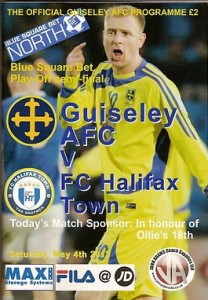 The results meant that Guiseley made it to their third successive Final against fellow Blue Square Bet North opponents FC Halifax Town. During the season the two sides had met on four occasions. The first two meetings were the League encounters with both fixtures ending 1-1. As Guiseley finished second in the table and FC Halifax Town finished fifth the clubs faced each other in the Play-off Semi-Final. In the 1st Leg game at The Shay in front of a 2,367 crowd, Town went ahead with a penalty from Dan Gardner, only for Danny Ellis to equalise in the second-half to bring about a third successive 1-1 outcome between the teams. Something had to give in the 2nd Leg and it did as Town took the game with second-half goals from Alex Johnson and Lee Gregory to seal a 3-2 aggregate win. The teams were as follows:
The results meant that Guiseley made it to their third successive Final against fellow Blue Square Bet North opponents FC Halifax Town. During the season the two sides had met on four occasions. The first two meetings were the League encounters with both fixtures ending 1-1. As Guiseley finished second in the table and FC Halifax Town finished fifth the clubs faced each other in the Play-off Semi-Final. In the 1st Leg game at The Shay in front of a 2,367 crowd, Town went ahead with a penalty from Dan Gardner, only for Danny Ellis to equalise in the second-half to bring about a third successive 1-1 outcome between the teams. Something had to give in the 2nd Leg and it did as Town took the game with second-half goals from Alex Johnson and Lee Gregory to seal a 3-2 aggregate win. The teams were as follows:
Guiseley AFC – (1) Steve Drench, (2) Aaron Hardy, (3) Rhys Meynell, (4) Andy Pearson, (5) Danny Ellis, (6) Matt Wilson, (7) Jack Rea, (8) Andy Holdsworth, (9) Josh Wilson, (10) James Walshaw, (11) Gavin Rothery. Subs: (12) Mark Bower, (14) Jake Lawlor, (15) Seb Carole, (16) Phil Marsh, (18) Jacob Giles.
FC Halifax Town – (1) Matt Glennon, (2) Ryan Toulson, (4) Scott McManus, (4) Liam Hogan, (5) Matt Pearson, (6) Danny Lowe, (7) Liam Needham, (8) Sean Williams, (9) Alex Johnson, (10) Dan Gardner, (11) Lee Gregory Subs: (12) Phil Senior, (14) Jon Worthington, (15) Gareth Seddon, (16) James Bolton, (19) Adriano Moke.
Whilst there was huge disappointment for Guiseley, The Shaymen went on to seal promotion to the Blue Square Bet Conference Premier Division with a 1-0 win over Brackley Town. Now both sides had one last fixture at Bradford; for Halifax the chance to end the season with a ‘double’ celebration, whilst for Guiseley the opportunity to gain a consolation in terms of a third consecutive County Cup win.
For the Final the crowd was only admitted to the lower tier of the Co-operative Stand, so for the spectators it was an eerie scene looking out on the rest of the ground where the claret and amber seats were empty. It was also hard to imagine that this was the same stadium where 28 years ago so many were tragically killed and injured in the Bradford fire, as all the old terraces and stands have since gone and been redeveloped. There is a feeling of lop-sidedness about the place now, as the main stand and Kop dwarf the Midland Road and TL Dallas stands, which was accentuated by the fact that these areas were empty for this game. Given that the season was at an end and the volume of games played on it, the pitch was in pretty good condition and certainly did not have any significant areas which were devoid of grass.
In the previous two Finals to be held at Valley Parade, the attendance had topped the 1,000 mark, but was on this occasion lower at 766. This may have been down to it coming just two days after Halifax gained promotion at Brackley and that it was a pretty chilly and damp evening. However, also part of the equation unfortunately, will be the fact that fans don’t see it as a priority and at the end of a long season, despite adult entry being only £7, people couldn’t be lured out. The reality is that all Cup competitions now suffer lower crowds which have hit the (Carling) League Cup and the FA Cup in recent years.
Whilst the fans may not have seen the Final as a being significant, it was a credit to both FC Halifax and Guiseley that they put out strong line-ups. Of the 32 players named in the Final, 22 (11 from each side) appeared in the 2nd Leg Play-off game at Guiseley. For the Final the teams were as follows:
FC Halifax Town: (1) Phil Senior, (2) James Bolton, (3) Jason St. Juste, (4) Ryan Toulson, (5) Matt Pearson, (6) Danny Lowe, (7) Adriano Moke, (8) Sean Williams, (9) Danny Glover, (10) Jon Worthington, (11) Gareth Seddon. Subs: (12) Matt Glennon, (14) Osebi Abadaki, (15) George Wysocki, (16) Josh Messer, (17) Alex Johnson
Guiseley AFC: (1) Steve Drench, (2) Andy Holdsworth, (3) Andy McWilliams, (4) Jack Rea, (5) Matt Wilson, (6) Mark Bower, (7) Seb Carole, (8) Gavin Rothery, (9) Josh Wilson, (10) James Walshaw, (11) Phil Marsh. Subs: (12) Wayne Brooksby, (14) Macaulay Parkinson, (15) Zack Dale, (16) Jacob Giles, (17) Luke Porritt.
 While the team lined up to be presented to the guest of honour, the Town fans made themselves heard with a chorus of “…Stand-up if you’re going up…”, just to make sure their opponents hadn’t forgotten the events of the last few days. Guiseley kicked off and had the better of the opening couple of minutes in terms of possession. However, it was Halifax who had the first attempt on goal of the game, when Gareth Seddon had a volley comfortably saved by Steve Drench. Encouraged by this Town started to dominate proceedings, with Glover prominent down the middle for The Shaymen and Moke getting wide. With nine minutes gone Halifax won the first corner of the game after a Seddon shot was deflected away. From the corner and play that switched across field, Seddon blazed the resulting effort over the bar. Halifax were growing in confidence and on twelve minutes, Adriano Moke collected the ball out wide on the left, cut in and curled his effort onto the bar. Guiseley struggled to get any foot-hold in the opening fifteen minutes, with their attacks limited to long balls forward which were often over-hit. However, on seventeen minutes The Lions at last fashioned a decent chance, as a shot from Seb Carole was parried but gathered at the second attempt by Town keeper Senior. This seemed to settle Guiseley as they had their best spell since the opening minutes of the game. However, Halifax stormed back and on nineteen minutes an excellent position from a free-kick was spurned by the taker Williams. Just three minutes later an ever better chance went begging when Seddon miskicked when well placed in the six-yard box. When Guiseley did get possession, they were unable to capitalise as they continued to give it away too easily. However, on the half-hour mark, The Lions had a shout for a penalty, as a shot from Josh Wilson struck Town defender Bolton who was on the ground; the referee rightly turned down the appeal. Halifax upped the tempo as in the space of five minutes they worked the flanks well to create good crossing opportunities, the first of which was well intercepted by Steve Drench and the other too long for the intended target Seddon. With ten minutes to go Guiseley created their best chance of the first-half as good work by Marsh released Walshaw who wastefully lashed the chance over the bar. It was certainly not a case of the half petering out quietly, as with thirty eight minutes on the clock, Town’s Seddon provided a knockdown for Moke which was drilled wide and then was quickly followed by a free-kick opportunity which was unfortunately wasted by St. Juste. Then with a minute to the break, Seddon disposed Guiseley keeper Drench, rounded him but saw his effort rebound back of the post, with nobody able to apply a finishing touch. It was by far the best chance of the half; in a forty five minutes which Halifax had created the better openings.
While the team lined up to be presented to the guest of honour, the Town fans made themselves heard with a chorus of “…Stand-up if you’re going up…”, just to make sure their opponents hadn’t forgotten the events of the last few days. Guiseley kicked off and had the better of the opening couple of minutes in terms of possession. However, it was Halifax who had the first attempt on goal of the game, when Gareth Seddon had a volley comfortably saved by Steve Drench. Encouraged by this Town started to dominate proceedings, with Glover prominent down the middle for The Shaymen and Moke getting wide. With nine minutes gone Halifax won the first corner of the game after a Seddon shot was deflected away. From the corner and play that switched across field, Seddon blazed the resulting effort over the bar. Halifax were growing in confidence and on twelve minutes, Adriano Moke collected the ball out wide on the left, cut in and curled his effort onto the bar. Guiseley struggled to get any foot-hold in the opening fifteen minutes, with their attacks limited to long balls forward which were often over-hit. However, on seventeen minutes The Lions at last fashioned a decent chance, as a shot from Seb Carole was parried but gathered at the second attempt by Town keeper Senior. This seemed to settle Guiseley as they had their best spell since the opening minutes of the game. However, Halifax stormed back and on nineteen minutes an excellent position from a free-kick was spurned by the taker Williams. Just three minutes later an ever better chance went begging when Seddon miskicked when well placed in the six-yard box. When Guiseley did get possession, they were unable to capitalise as they continued to give it away too easily. However, on the half-hour mark, The Lions had a shout for a penalty, as a shot from Josh Wilson struck Town defender Bolton who was on the ground; the referee rightly turned down the appeal. Halifax upped the tempo as in the space of five minutes they worked the flanks well to create good crossing opportunities, the first of which was well intercepted by Steve Drench and the other too long for the intended target Seddon. With ten minutes to go Guiseley created their best chance of the first-half as good work by Marsh released Walshaw who wastefully lashed the chance over the bar. It was certainly not a case of the half petering out quietly, as with thirty eight minutes on the clock, Town’s Seddon provided a knockdown for Moke which was drilled wide and then was quickly followed by a free-kick opportunity which was unfortunately wasted by St. Juste. Then with a minute to the break, Seddon disposed Guiseley keeper Drench, rounded him but saw his effort rebound back of the post, with nobody able to apply a finishing touch. It was by far the best chance of the half; in a forty five minutes which Halifax had created the better openings.
 Guiseley made a substitution at the start of the second-half with Phil Marsh replaced by Wayne Brooksby. Halifax kicked off and were immediately on the attack through Gareth Seddon, but his cross came to nothing. This was typical of the play in the opening five minutes as neither team settled into any sort of rhythm. However, on fifty one minutes the first corner of the second period was won by Guiseley; Gavin Rothery took it but the opportunity was wasted as it cleared the box and went straight out. Town responded immediately as after good work by Jason St. Juste out wide, Seddon had a shot on goal which was deflected for a corner. Moke took the kick, but the header from Bolton was off target. It was a good little spell for Halifax as they played on the break and created shooting opportunities for Sean Williams and Adriano Moke. As the game started to open-up, Guiseley countered with a period of pressure themselves, as James Walshaw had a shot from inside the box deflected for a corner. However, as with earlier in the half, a poor delivery meant the chance was wasted. With the game approaching the hour mark, The Lions kept up the pressure with an effort from Gavin Rothery, but it was straight at the keeper and easily gathered. Back came Town with two chances in a minute, but the efforts from Worthington and Seddon were comfortably dealt with by Drench in the Guiseley goal. On sixty six minutes, The Shaymen made their first substitution of the night as Danny Glover was replaced by Alex Johnson. Town continued to press and Moke created a shooting chance for St. Juste, but the effort drifted wide. On seventy minutes Town were forced into a second change, as the injured Worthington was replaced by Josh Messer and Guiseley also made a change with James Walshaw taken off (much to the delight of the Halifax faithful), with Zack Dale coming on. The substitutions and the persistent rain seemed to have a dampening effect on the game, with the play decidedly disjointed and even the hard-core fans of both sides reduced to barely a murmur. The gloom was broken by jeers from the Town fans when on seventy four minutes a free-kick taken by Guiseley’s Rothery saw the player slip over and end up on his backside. A couple of minutes later Halifax had an excellent chance to take the lead when substitute Messer found himself one-on-one with Guiseley keeper Drench, but the shot lacked strength and was easily gathered. Indeed as the game entered the last ten minutes it was The Shaymen who looked more likely to grab a winner with Moke a constant threat and shooting chances for Seddon, Williams and St. Juste. Guiseley struggled to get any possession in the closing period, but had a chance two minutes from time with a free-kick in a good position. However, the effort from Josh Wilson was high and wide and extra-time loomed ever closer. As the game went into the final minute of normal time, Town’s Moke provided another shooting chance for Sean Williams, but the effort was blocked. With the ninety minutes up, there were two minutes of time added-on for the teams to break the deadlock and once again Moke created the opportunity for The Shaymen after good work by him resulted in a corner. Jason St. Juste took the kick, but substitute Alex Johnson could only glance the header wide and so it was extra-time.
Guiseley made a substitution at the start of the second-half with Phil Marsh replaced by Wayne Brooksby. Halifax kicked off and were immediately on the attack through Gareth Seddon, but his cross came to nothing. This was typical of the play in the opening five minutes as neither team settled into any sort of rhythm. However, on fifty one minutes the first corner of the second period was won by Guiseley; Gavin Rothery took it but the opportunity was wasted as it cleared the box and went straight out. Town responded immediately as after good work by Jason St. Juste out wide, Seddon had a shot on goal which was deflected for a corner. Moke took the kick, but the header from Bolton was off target. It was a good little spell for Halifax as they played on the break and created shooting opportunities for Sean Williams and Adriano Moke. As the game started to open-up, Guiseley countered with a period of pressure themselves, as James Walshaw had a shot from inside the box deflected for a corner. However, as with earlier in the half, a poor delivery meant the chance was wasted. With the game approaching the hour mark, The Lions kept up the pressure with an effort from Gavin Rothery, but it was straight at the keeper and easily gathered. Back came Town with two chances in a minute, but the efforts from Worthington and Seddon were comfortably dealt with by Drench in the Guiseley goal. On sixty six minutes, The Shaymen made their first substitution of the night as Danny Glover was replaced by Alex Johnson. Town continued to press and Moke created a shooting chance for St. Juste, but the effort drifted wide. On seventy minutes Town were forced into a second change, as the injured Worthington was replaced by Josh Messer and Guiseley also made a change with James Walshaw taken off (much to the delight of the Halifax faithful), with Zack Dale coming on. The substitutions and the persistent rain seemed to have a dampening effect on the game, with the play decidedly disjointed and even the hard-core fans of both sides reduced to barely a murmur. The gloom was broken by jeers from the Town fans when on seventy four minutes a free-kick taken by Guiseley’s Rothery saw the player slip over and end up on his backside. A couple of minutes later Halifax had an excellent chance to take the lead when substitute Messer found himself one-on-one with Guiseley keeper Drench, but the shot lacked strength and was easily gathered. Indeed as the game entered the last ten minutes it was The Shaymen who looked more likely to grab a winner with Moke a constant threat and shooting chances for Seddon, Williams and St. Juste. Guiseley struggled to get any possession in the closing period, but had a chance two minutes from time with a free-kick in a good position. However, the effort from Josh Wilson was high and wide and extra-time loomed ever closer. As the game went into the final minute of normal time, Town’s Moke provided another shooting chance for Sean Williams, but the effort was blocked. With the ninety minutes up, there were two minutes of time added-on for the teams to break the deadlock and once again Moke created the opportunity for The Shaymen after good work by him resulted in a corner. Jason St. Juste took the kick, but substitute Alex Johnson could only glance the header wide and so it was extra-time.
With the rain continuing to fall, Halifax started the first period the better of the teams, getting forward and maintaining possession. Five minutes in, Town appealed for a penalty when Matt Pearson went down after a challenge by Jack Rea, but the referee quickly turned it down. A couple of minutes later Guiseley had their first chance in extra-time, however, Josh Wilson pulled his shot wide. That was a rare moment of pressure from The Lions as Halifax continued to hold the upper hand and with the game entering the hundredth minute, the dangerous Moke got wide and crossed invitingly into the box. Despite having space, Alex Johnson could only head wide. Guiseley then made their last substitution with Jack Rea making way for Macaulay Parkinson. The rain was making conditions difficult and both sides hit a scrappy spell. Just when it looked like the game was going to remain goal-less at the end of the first period of extra-time, The Shaymen struck. Alex Johnson played a through ball to Gareth Seddon who collected it and from just inside the box, beautifully curled his shot into the top corner; a moment of quality which gave Halifax a 1-0 lead.
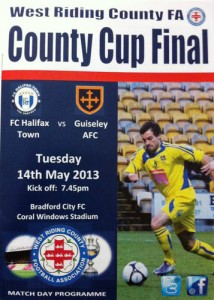 In the second period, with Guiseley in need of an equaliser, Seb Carole prompted The Lions search, but the Halifax defence held firm. However, for all their pressure and domination of the opening ten minutes of the half, Guiseley couldn’t turn their possession into actual chances. As the clock showed there were just five minutes to go, Halifax dug deep into their reserves and mounted some pressure of their own. First Alex Johnson was released on goal, but was flagged off-side and a couple of minutes later, Seddon had a long-range effort charged down. The Lions weren’t done though and with three minutes to go, Halifax just about cleared a corner from Guiseley. The final minutes proved to be nervous for Town as Guiseley continued to press with even keeper Steve Drench going forward. However, it was not to be for the team from Nethermoor and at the whistle it was Halifax who celebrated.
In the second period, with Guiseley in need of an equaliser, Seb Carole prompted The Lions search, but the Halifax defence held firm. However, for all their pressure and domination of the opening ten minutes of the half, Guiseley couldn’t turn their possession into actual chances. As the clock showed there were just five minutes to go, Halifax dug deep into their reserves and mounted some pressure of their own. First Alex Johnson was released on goal, but was flagged off-side and a couple of minutes later, Seddon had a long-range effort charged down. The Lions weren’t done though and with three minutes to go, Halifax just about cleared a corner from Guiseley. The final minutes proved to be nervous for Town as Guiseley continued to press with even keeper Steve Drench going forward. However, it was not to be for the team from Nethermoor and at the whistle it was Halifax who celebrated.
For Town it was the second occasion they have lifted the West Riding FA County Cup, whilst for Guiseley there was no third successive win. Both sides now look forward to the summer break. When the 2013/14 season kicks-off, The Shaymen will be just one promotion away from a return to the Football League. For The Lions, they will look to regroup and see if they can make it out of the Conference North after the Play-off defeats of the last two seasons. But for now, goodbye to the 2012/13 season…
 Wool City Rivals: A History in Colour, is the seventh book from bantamspast, who as a publisher continue to create, “a collection of complementary books to provide a definitive history of Bradford soccer from the beginnings until the present day.” To date the six other titles are as follows:
Wool City Rivals: A History in Colour, is the seventh book from bantamspast, who as a publisher continue to create, “a collection of complementary books to provide a definitive history of Bradford soccer from the beginnings until the present day.” To date the six other titles are as follows: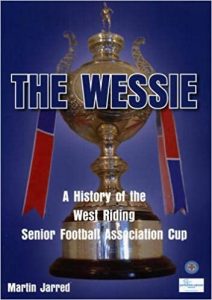 The FA Cup is recognised as the oldest cup competition in the World with it first being played during 1871/72, when Wanderers beat the Royal Engineers 1-0 at the Oval in London. It predated the first Football League Championship in England by seventeen years, when Preston North End took the title.
The FA Cup is recognised as the oldest cup competition in the World with it first being played during 1871/72, when Wanderers beat the Royal Engineers 1-0 at the Oval in London. It predated the first Football League Championship in England by seventeen years, when Preston North End took the title.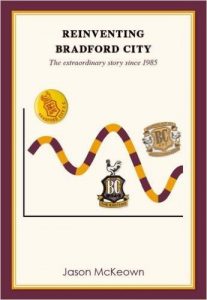 Reinventing Bradford City is the second part of a four volume series under the banner of History Revisited from Bantamspast. The first book was the well received, A History of Bradford City AFC in Objects, by John Dewhirst published in 2014.
Reinventing Bradford City is the second part of a four volume series under the banner of History Revisited from Bantamspast. The first book was the well received, A History of Bradford City AFC in Objects, by John Dewhirst published in 2014.
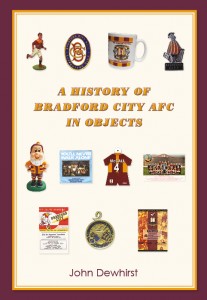 Imagine visiting an exhibition that told the story of your football club through a myriad of ephemera, memorabilia and club relics; room upon room of programmes, badges and medals, oozing with the history and tradition of the team you support.
Imagine visiting an exhibition that told the story of your football club through a myriad of ephemera, memorabilia and club relics; room upon room of programmes, badges and medals, oozing with the history and tradition of the team you support.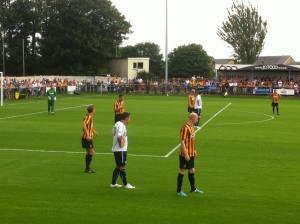
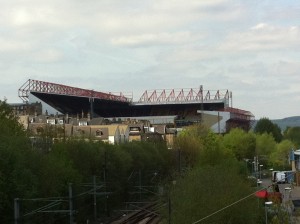
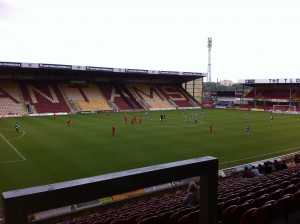 With both teams now tiring, the extra thirty minutes unsurprisingly lost some of the bite and intensity of the first ninety minutes. Carole looked threatening as he ran at The Eagles defence, but was unable to create a genuine opportunity for his side. For Eccleshill, their one major chance was created by the ever willing Marcus Edwards. His run down the by-line, through a fatigued Knaresborough defence was only halted by a brave save at his feet by the outstanding Borough keeper Weston Murau. At the whistle and after 120 minutes, players from both sides sportingly shook hands and congratulated the match officials on what had been a draining, but enjoyable Cup Final. They knew though now it was down to the lottery that is penalties.
With both teams now tiring, the extra thirty minutes unsurprisingly lost some of the bite and intensity of the first ninety minutes. Carole looked threatening as he ran at The Eagles defence, but was unable to create a genuine opportunity for his side. For Eccleshill, their one major chance was created by the ever willing Marcus Edwards. His run down the by-line, through a fatigued Knaresborough defence was only halted by a brave save at his feet by the outstanding Borough keeper Weston Murau. At the whistle and after 120 minutes, players from both sides sportingly shook hands and congratulated the match officials on what had been a draining, but enjoyable Cup Final. They knew though now it was down to the lottery that is penalties. The first winners of the County Cup were Leeds United Reserves in 1927 and apart from 1932 and the period from 1934 to 1949, it has been played for every season since. Goole AFC have won the trophy on most occasions with 13 wins, the first of which came in 1951 when they were known as Goole Town. Their last Cup win was in 2007 at Woodlesford (West Riding County FA Headquarters), when they beat Guiseley 3-1 with goals from Andy Parton and a brace from Duncan Bray.
The first winners of the County Cup were Leeds United Reserves in 1927 and apart from 1932 and the period from 1934 to 1949, it has been played for every season since. Goole AFC have won the trophy on most occasions with 13 wins, the first of which came in 1951 when they were known as Goole Town. Their last Cup win was in 2007 at Woodlesford (West Riding County FA Headquarters), when they beat Guiseley 3-1 with goals from Andy Parton and a brace from Duncan Bray.


 In the second period, with Guiseley in need of an equaliser, Seb Carole prompted The Lions search, but the Halifax defence held firm. However, for all their pressure and domination of the opening ten minutes of the half, Guiseley couldn’t turn their possession into actual chances. As the clock showed there were just five minutes to go, Halifax dug deep into their reserves and mounted some pressure of their own. First Alex Johnson was released on goal, but was flagged off-side and a couple of minutes later, Seddon had a long-range effort charged down. The Lions weren’t done though and with three minutes to go, Halifax just about cleared a corner from Guiseley. The final minutes proved to be nervous for Town as Guiseley continued to press with even keeper Steve Drench going forward. However, it was not to be for the team from Nethermoor and at the whistle it was Halifax who celebrated.
In the second period, with Guiseley in need of an equaliser, Seb Carole prompted The Lions search, but the Halifax defence held firm. However, for all their pressure and domination of the opening ten minutes of the half, Guiseley couldn’t turn their possession into actual chances. As the clock showed there were just five minutes to go, Halifax dug deep into their reserves and mounted some pressure of their own. First Alex Johnson was released on goal, but was flagged off-side and a couple of minutes later, Seddon had a long-range effort charged down. The Lions weren’t done though and with three minutes to go, Halifax just about cleared a corner from Guiseley. The final minutes proved to be nervous for Town as Guiseley continued to press with even keeper Steve Drench going forward. However, it was not to be for the team from Nethermoor and at the whistle it was Halifax who celebrated. Saturday 11 May 1985 should have been a day of celebration at Valley Parade as Bradford City paraded the trophy after winning the 1984/85 Third Division title. Instead it became an occasion of horror, devastation and sadness. Towards the end of the first-half in the game against Lincoln City, a small flame was seen underneath an area of seats, but which in minutes turned the whole stand into an inferno. 56 people lost their lives and hundreds more were injured.
Saturday 11 May 1985 should have been a day of celebration at Valley Parade as Bradford City paraded the trophy after winning the 1984/85 Third Division title. Instead it became an occasion of horror, devastation and sadness. Towards the end of the first-half in the game against Lincoln City, a small flame was seen underneath an area of seats, but which in minutes turned the whole stand into an inferno. 56 people lost their lives and hundreds more were injured.